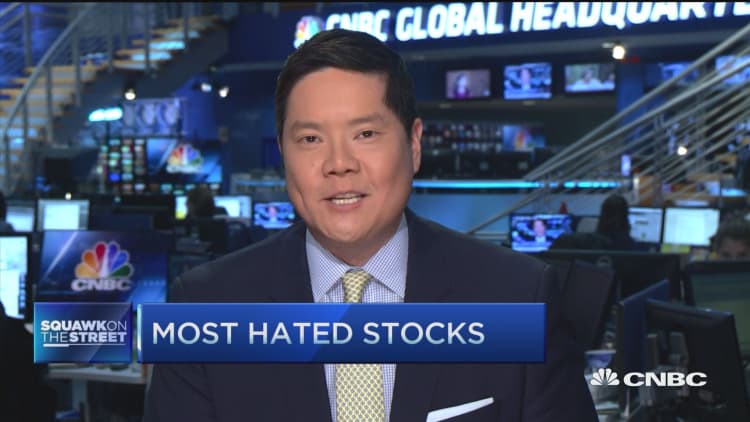


U.S. stocks closed mixed Monday, steadying after their first three-week rally of the year so far, as gains in energy stocks offset declines in technology.
"A lot of people have been short some of those names so I think you're seeing a short squeeze," Robert Pavlik, chief market strategist at Boston Private Wealth, said, noting a continued shift from growth to value stocks.
The Dow Jones industrial average posted its first five-straight days of gains since October. Chevron, IBM and Exxon Mobil contributed the most to gains. Visa and Nike were the greatest contributors to declines.
The S&P 500 also posted a five-day win streak by eking out a gain and topping 2,000 in the close. Energy rose nearly 2.4 percent as the top advancer, while information technology ended about 0.7 percent lower as the greatest decliner. Over the last four weeks, the sector is up about 9 percent from its intraday low.
"I don't think it's a whole lot more than, we had a significant rise over a three-week period. Anybody that's getting hit today is ... up significantly over a three-week basis," said Art Hogan, chief market strategist at Wunderlich Securities.
The Nasdaq composite underperformed as the only index of major three to close a touch lower, weighed by declines of about 2 percent or more in shares of Microsoft, Facebook, Amazon and Alphabet.
Gains in oil supported the rise in energy stocks. Brent crude topped $40 a barrel for the first time in 2016, while WTI briefly topped $38 a barrel in intraday trade and settled up $1.98 at $37.90 a barrel, its highest level of the year so far.
"I think it's a little bit of profit-taking on people who are long the market, and people who are short the market are still covering," said Dan Veru, chief investment officer at Palisade Capital Management.
The major averages opened lower and traded sideways for much of the session, before closing mixed.
Ilya Feygin, managing director and senior strategist at WallachBeth Capital, said investors shouldn't read too much into the intraday moves.
"I think liquidity is poor and small waves of institutional selling (or buying) could move 20 points," he said, noting much of the action was technical positioning in high beta names.
The Russell 2000 outperformed the major U.S. averages, rising more than 1 percent.
"We're back to the same positive path where the market opened lower, with some profit-taking based on what happened in the foreign markets. Any dip should be buyable," said Marc Chaikin, CEO of Chaikin Analytics.
"Overall, the mood of the market has changed," he said. "We've changed from fear of recession to fear of missing out on the up-move."
Read MoreWall Street's 7-year-old bull could slow after sharp rally
The key event in the data-light week is the European Central Bank's Thursday meeting,
Fed Governor Lael Brainard argued for patience in raising rates. She said inflation is persistently under target but should move back to the 2 percent target despite downside risks.
Separately, Fed Vice Chairman Stanley Fischer said inflation is showing signs it could accelerate in the United States. He did not comment on whether the Fed was likely to raise interest rates this year, Reuters said.
The Federal Open Market Committee meets March 15 to 16.
The U.S. dollar index turned lower, while the euro rose above $1.10. Treasury yields were higher, with the 2-year yield near 0.91 percent, its highest since Jan. 14. The 10-year yield traded around 1.90 percent after earlier hitting 1.92, its highest since Feb. 2.
European stocks pared losses to close mildly lower.
Asian stocks closed mixed, with the Shanghai composite ending about 0.8 percent higher. Over the weekend, Chinese Premier Li Keqiang announced a 2016 target GDP growth range between 6.5 percent and 7 percent.
China's foreign exchange reserves declined less than expected in February, but still fell to their lowest level since December 2011 at $3.20 trillion, Reuters said Monday, citing data from the People's Bank of China.
Major U.S. Indexes
U.S. stocks ended a choppy Friday session with gains, helped by a rise in oil prices and a jobs report that showed economic growth without necessarily inducing the Fed to raise rates earlier.
Read More Early movers: AAPL, MENT, DIS, AMZN, T, UAL, STX, RAI, UBS & more
The Dow Jones industrial average closed up 67.18 points, or 0.40 percent, at 17,073.95, with Chevron leading advancers and Nike the greatest decliner.
The closed up 1.77 points, or 0.09 percent, at 2,001.76, with energy leading six sectors higher and information technology the biggest laggard.
The Nasdaq composite closed down 8.77 points, or 0.19 percent, at 4,708.25.
The CBOE Volatility Index (VIX), widely considered the best gauge of fear in the market, held above 17.
About two stocks advanced for every decliner on the New York Stock Exchange, with an exchange volume of 1.1 billion and a composite volume of nearly 5.0 billion.
Gold futures settled $6.70 lower at $1,264 an ounce.
On tap this week:
Tuesday
6 a.m. NFIB survey
1 p.m. $24 billion 3-year notes auction
Wednesday
7 a.m.: Mortgage applications
10 a.m. Wholesale trade
1 p.m. $20 billion 10-year notes auction
Thursday
European Central Bank meeting
8:30 a.m. Weekly claims
10 a.m. Quarterly Services Survey
10:30 a.m.: Natural gas inventories
1 p.m. $12 billion 30-year bonds auction
2 p.m. Federal budget
Friday
8:30 a.m. Import prices
1 p.m.: Oil rig count
*Planner subject to change.
More From CNBC.com:


